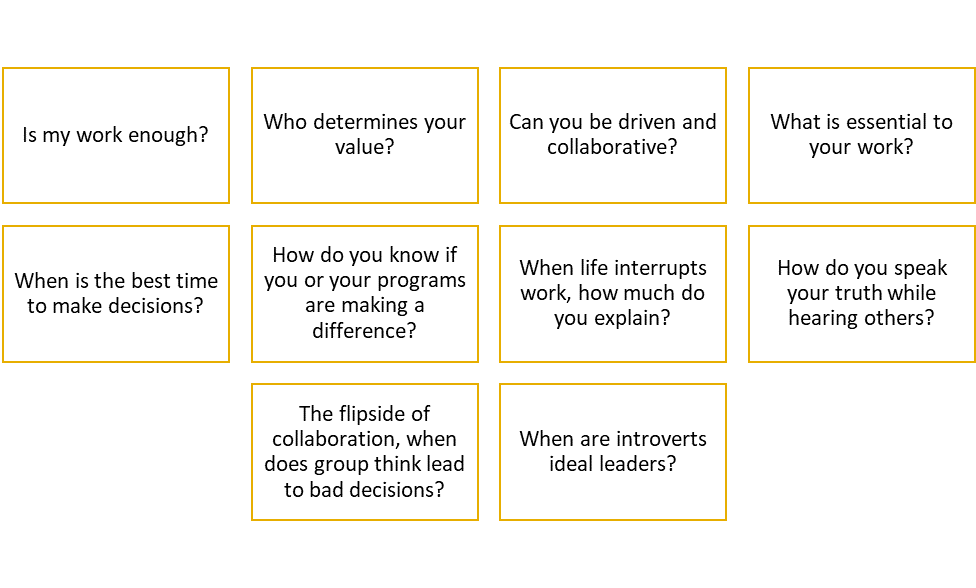When I asked organizational leaders, what are the top 3 work related things that get them up in the morning, one respondent answered, my question with a question: “Is it bad that I can’t think of three things…?” Others, gave glib answers like coffee, knowing it is a Friday, etc. You are not alone if you find yourself struggling. Struggling to be motivated in the morning to go to work, if you dread that commute, your tasks, your coworkers, the stress. But does it mean that your current position and current organization are a bad fit? Maybe. Maybe not. How do you determine if it is? And if you determine it is a bad fit, how do you determine what’s next? If you determine it is not a bad fit, what’s next? How do you reengage?
[yop_poll id=”2″]
Typically, when our decisions are fraught with strong emotions, we fall into a fight or flight pattern. We may be tempted to make a quick angry decision to quell our negative feelings or we may shut down and find ourselves disconnected from our work or our organization; overwhelmed by apathy.
One of my clients found himself feeling disconnected from his organization. Every morning was a struggle. After years of working his way through his organization to roles with increasing responsibility and influence, he found his current role lonely and frustrating. He was no longer working directly with clients, but he also found it difficult to make the systemic changes required at his level of leadership. He wasn’t sure if the barriers were surmountable and he had started to question if he was the right person to address them. His organization faced resource constraints. Those constraints and some changes in leadership had stirred up some smoldering tensions among the staff. Those tensions left him drained at the end of each day and dreading the drama each morning. One day, he was unable to find a good solution to an issue a staff member brought to him that impacted several client families. That afternoon, he overheard staff grumbling about a policy change he had instituted to address the resource constraints. His frustration bubbled over. He was ready to simply throw in the towel and move on to another endeavor. It was tempting to use the situation as a catalyst to start looking for his next venture.
Another of my clients found herself feeling combative. Every morning was a struggle. She and the organization were bumping up against barriers to serving their stakeholders that included competition with other organizations who could have been partners. This feeling of frustration had been mounting for some time but came to a head when she found herself in conflict with another organizational leader at a community meeting. The meeting had been heated and had left her angry and agitated. She was ready to take that organization on head first – to call them out on their unwillingness to work with others and collaborate. She was ready for a fight.
The trouble with making decisions when we are emotional though is that high emotions cloud our thinking. We only see exits and battles. Emotions shouldn’t be used as a decision-making process. We don’t need to discount emotions entirely, especially for personal decisions. But our emotional responses to a situation should be treated as evidence or information that goes into decision making and not the decision itself. In order for my clients to use their strong emotions in their decision making, they needed to first shut down their fight or flight response. To do so requires a new perspective.
Shawn Achor in his second book: Before Happiness, argues that beyond IQ, beyond even Emotional and Social Intelligence, happiness and success are dependent on “the ability to see a reality in which success is possible.” This is not to say that we all need to ignore a negative reality. It does not mean that either of my clients should have ignored their anger, frustration, apathy, and feelings of unease. These emotional responses are real and are evidence that a decision needs to be made. What Shawn Achor argues though is that in order to move forward (in our current positions or in new endeavors) we need to know that we have agency in changing that reality (or at least our role in it). Success, according to Achor, is “not just about how much intelligence you have; it is about how much of your intelligence you believe you can use.” It requires us to use our IQ, our emotional, and our social intelligence, but in order to do so successfully, we need to change the frame through which we see possible realities. There are many ways to change our frame: meditation, exercise, engaging in new learning opportunities, etc. One of the most direct means though is to develop our first sight and our second thoughts.
As was explained to Tiffany Aching in Terry Prachett’s hilarious book: Wee Free Men: “First Sight is when you see what’s really there, not what your heid tells you ought to be there.” Tiffany later gives an example of second thoughts: “But she was aware of hundreds of nervous faces in the shadows. How you deal with this is going to be important, said her Second Thoughts.” As a leader, you are good at providing first sight and second thoughts for others. You see the possibilities for your stakeholders, your staff, your community. You step back and think about your approach before you act. It is what has gotten you to where you are in your career. What can be tricky is seeing those possibilities for yourself or when yours and others’ emotions are running high.
Find some time this week to take 10 minutes to have a cup of tea, coffee, a glass of wine, a beer…(whatever your favorite beverage is) with yourself. Reflect on (and jot down) the times when you have experienced negative emotions, what options did you see? When you were experiencing positive emotions, what options did you see? Was there a difference based on your mood in the number of options you perceived, the quality of the options, the creativity in the options?
Next Monday, we will explore asking questions as a means to shift our perspective and the options we see as available to us.


